A major factor in the New York Rangers’ rise toward the top of the Metropolitan Division this season has been definition.
The team has forged a well-defined personality under coach Gerard Gallant, one of grit and responsibility and togetherness. On a more granular level, players have defined roles, demonstrated perfectly by a long-sought physical fourth line that’s been expertly deployed by Gallant. Defensemen understand their roles in the offensive and defensive zones alike. Expectations and personnel on special teams are clear and consistent.
It’s added up to a 30-13-4 record and hopes for a deep playoff run. Yet no team is perfect, and if the Rangers really want to go far in the playoffs, there’s one area that’s sorely in need of such definition as the club moves into the final 35 games of its schedule.

That would be the third forward unit, a vexing problem that Gallant has been unable to solve, yet hasn’t been a huge issue to this point. The fact is, though, that if the Blueshirts want to make noise in the postseason, they’re going to need a third line that can contribute at a significant level.
While the rest of the team has found its identity, the third line has looked like a holdover from the David Quinn era: constantly rotating personnel, no clear expectations and ultimately, little production. When it comes to this area, Gallant has appeared just as confused in which direction to go as Quinn did.
As With Quinn, Gallant’s “Kid Line” Attempt Didn’t Work
In fact, Gallant’s most prominent attempt to mold a set unit was an idea Quinn tried last season: A proverbial “Kid Line,” the current coach putting together 20-somethings Alexis Lafreniere, Filip Chytil and Julien Gauthier in hopes of creating a trio that would provide energy, skill and some offense to complement the club’s potent top two lines.
It worked for a while, with Gauthier getting a chance to showcase his straight-line speed and power along the walls, and Chytil flashing the high-end tools at center that had the Rangers hoping he was finally fulfilling his potential as a future top-six staple. Teaming them with Lafreniere, the top overall draft pick in 2020, seemed like a good way to continue his development without forcing him onto one of the top forward units.
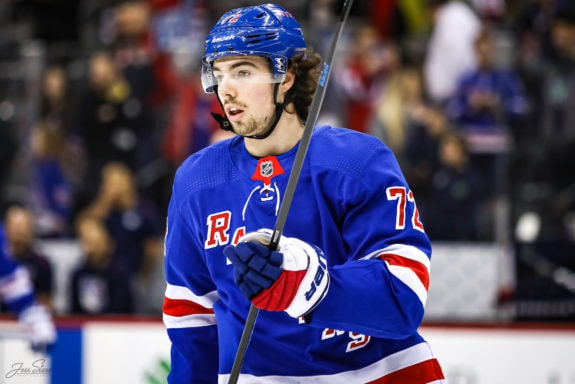
Until it didn’t. The grouping’s effectiveness waned, and Gallant and the organization have seemed to quietly give up on the idea of Chytil as a center, recently pushing him to the right wing, where he’s proved to be most effective in his four-plus NHL seasons.
Lafreniere has been moved up to right wing, his off side, with Chris Kreider and Mika Zibanejad, getting his first extended chance to seize the top-line role the Blueshirts of course envision for him. Gauthier has gone back to bouncing in and out and around the lineup, largely filling in when injury or COVID-related absences open a spot.
Those health issues, especially when it came to COVID, have also led to the coach relying on eager but short-term solutions in AHL regulars and taxi-squad members Jonny Brodzinski, Morgan Barron, Anthony Greco and Tim Gettinger at various times. The revolving door to the third line hasn’t stopped spinning.
It’s time for Gallant to bring that to end and move that unit into alignment with the rest of the team, and he knows it.
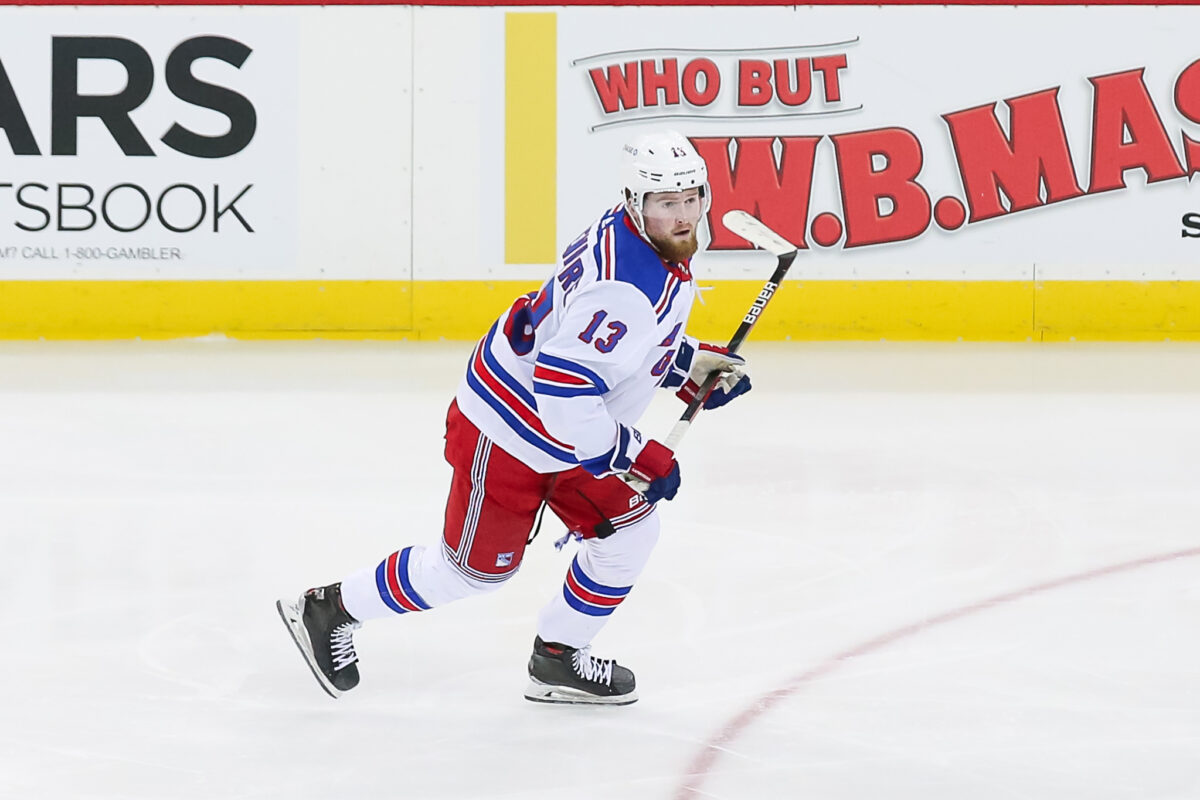
“I’ve gone back and forth way too much,” said Gallant, speaking generally about the roster but emphasizing the bottom-six forward group. “And it’s not because that’s what I want to do. It’s because sometimes that’s what you have to do. I look over there and I’m saying, ‘Who’s going to best fit there tonight?’
“I wish I could just roll my four lines all year long, but with COVID and everything else going on and injuries right now, you try different people in different spots.” (From ‘Gerard Gallant Plans to Shift Rangers’ Lines During All-Star Break’, New York Post, 2/1/22)
Goodrow the Key to a Versatile, Effective Third Forward Unit
With coronavirus numbers dropping throughout the country and the promise of fewer pandemic-related absences from his lineup, the coach should have increased options and the chance for more consistency in personnel on the third line. Yet health has only been half of the problem.
Assuming Gallant has his full roster available following the team’s 13-day layoff for the All-Star break, who will he choose to finally construct a trio that can be counted on to contribute regularly in (theme alert) a defined role? And what exactly will he expect that line to provide?
Perhaps the best option is a unit with hybrid responsibilities, one that can check and play sound defense but also deliver some scoring. The place to begin would be with the team’s ultimate hybrid player, by making him the literal and figurative center of that group: Barclay Goodrow.
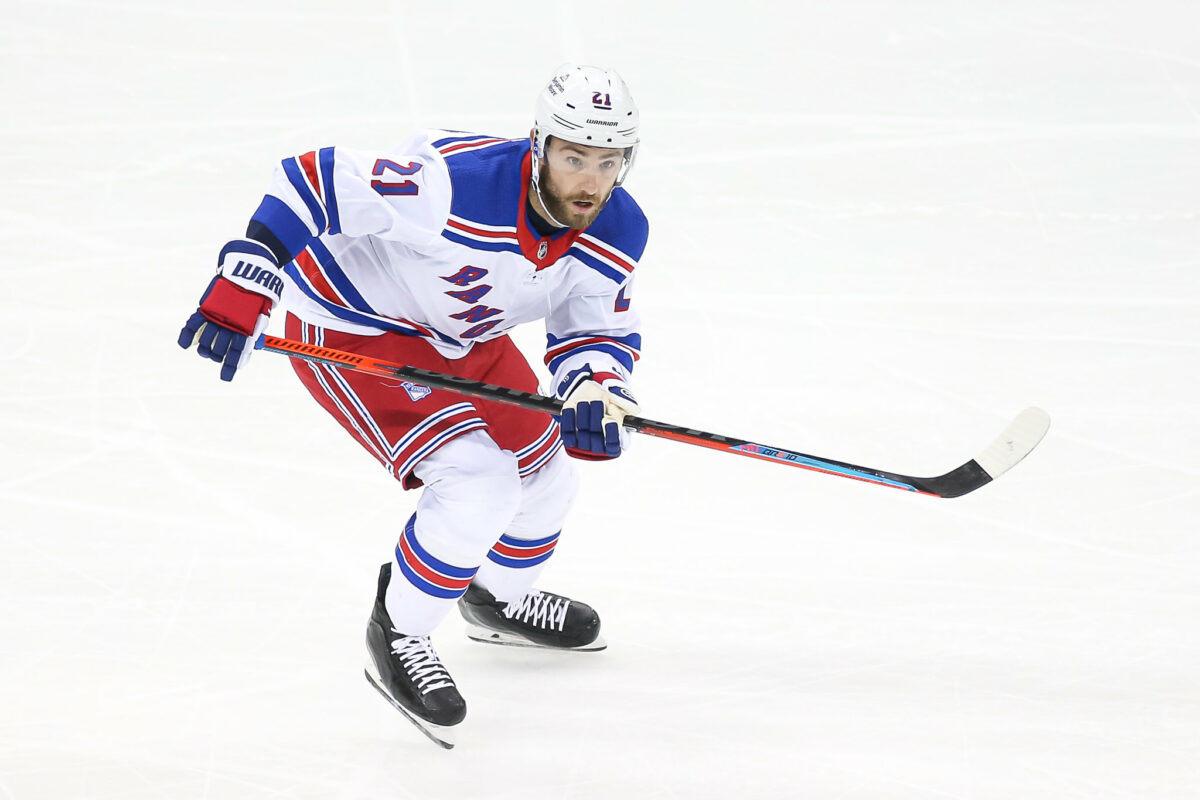
The offseason acquisition has been everything the Rangers could have hoped for and more, and he’s thrived on Gallant’s use of him as a Swiss Army knife: Goodrow has played on all four lines and all three forward positions when needed. He’s stepped up at right wing on both of the top two lines, centered the third and fourth units and also spent time on left wing with fourth-line stalwarts Kevin Rooney and Ryan Reaves.
However, putting Goodrow in the middle – where Gallant prefers him – and leaving him there going forward would anchor the third unit and give it the identity it badly needs. Goodrow has complemented his physical play, penalty killing and outstanding defensive work with 10 goals, 10 assists and solid efforts at the faceoff dot.
Staying with the grit theme for the left wing on this theoretical line, the Rangers’ most likely options would be Dryden Hunt or Greg McKegg. Hunt has largely played well this season and fits Gallant’s style with his hounding of the puck and straight-line physical play, but he’s been forced into a top-six role at times due to depth issues. He also possesses some skill and might be an appealing option on Goodrow’s left flank.
Related: Rangers’ Goodrow Having Career Year in First Season in Big Apple
If Gallant would prefer Hunt’s forecheck and hitting on the fourth line, enhancing the strengths of Rooney and Reaves, McKegg is a solid defensive presence and also provides some grind.
Perhaps Barron, whose strength along the boards and in front of the net has impressed Gallant in limited duty this season, might also work on the left.
The right side, in contrast, should be a player who thinks offense first. The best such option is Chytil, whose elite hands, speed and ability to break down a defense would give the line some dynamism and a sure goal-scoring threat. Chytil is also a better defensive player than he gets credit for, again fulfilling the theme of versatility and well-rounded play for the third line.
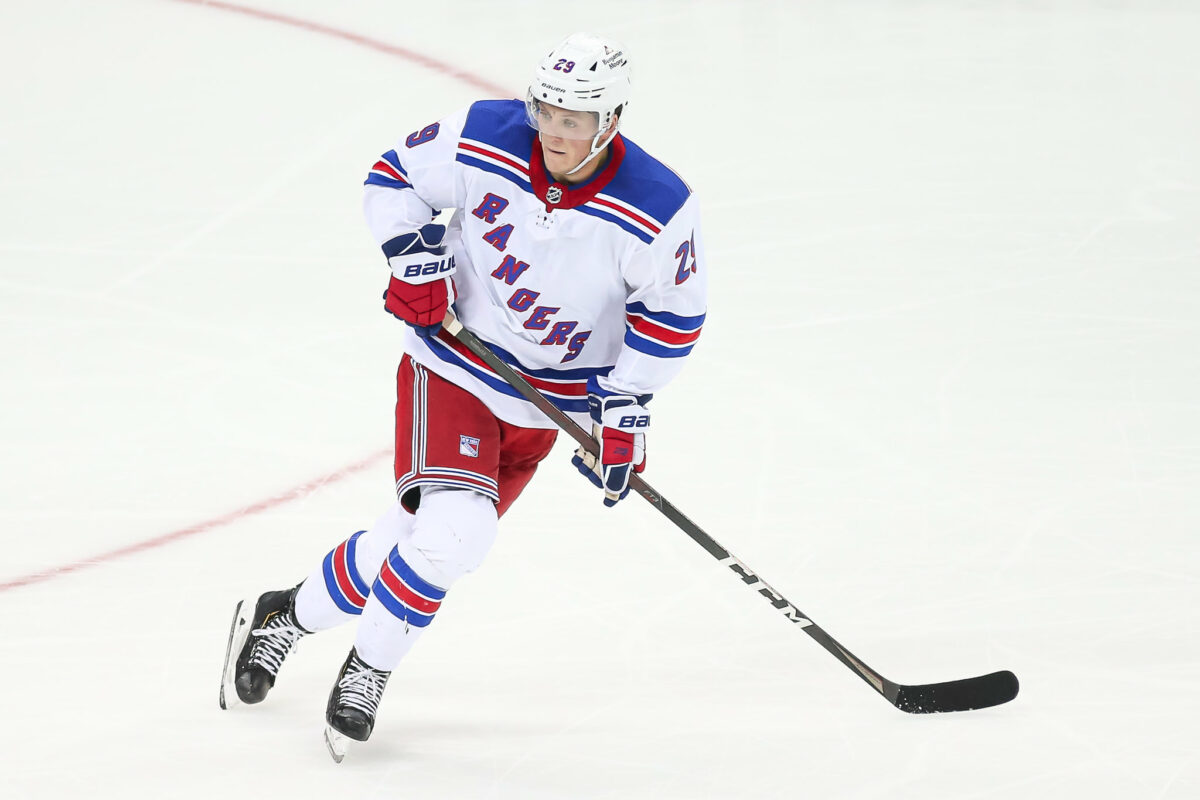
Gauthier can be held in reserve, able to provide some of what Chytil does and a clear option if Chytil fails to produce or doesn’t work well with Goodrow and Hunt/McKegg.
It’s worth a try. Goodrow has been a critical addition to this rising club, and building a forward group around his strengths might allow the Rangers to get the most out of him, while finally cementing a unit that’s consistently effective and solidifies the bottom six.
Rangers’ Inability to Forge a Third Line Might Cost Them in Playoffs
Is this overstating the importance of finding a regular third line, especially on a Rangers club that sports such a gaudy record? Not at all. A career season from Kreider, typically elite efforts from Zibanejad and Artemi Panarin and the aforementioned success of the fourth line have covered up the uncertainty on the third unit. Yet the weakness there is all but certain to get exposed in the playoffs, if not before, when the checking gets tighter and a team’s top two lines face difficult matchups from tougher opponents every game.
“Put your lines together, put your ‘D’ pairs together and assess what the first half of the season was like and what we’ve got to get better at,” Gallant said. “And there’s definitely some things. I like our record, but we’ve got to get better at some things.”

You don’t have to go back that far for compelling proof of the need for third-line production – just about eight years. The Rangers’ unexpected run to the 2014 Stanley Cup Final was a study in depth, and their formidable third unit of Mats Zuccarello, Derick Brassard and Benoit Pouliot was Exhibit A. The trio totaled 16 goals and 19 assists during that postseason, making opponents pay for focusing on shutting down the Kreider-Derek Stepan-Rick Nash and Carl Hagelin-Brad Richards-Martin St. Louis lines.
Whatever configuration Gallant opts for coming out of the break, he’ll most likely have to adjust again around the March 31 trade deadline. With the Rangers having $35.3 million in salary-cap space available at the deadline and the capital necessary to make multiple trades, it would border on irresponsible for general manager Chris Drury to not bolster the lineup by acquiring a rental player or two. High on his list is a power winger who can play in the top six and replace the contributions of Sammy Blais, who was lost for the season in November.
Assuming that happens, Lafreniere could be forced back down to the third line, perhaps pushing Hunt to the right side on that unit in order to maintain some extra grind in the grouping. Gallant might find himself shuffling the third-line deck all season as he searches for the right mix and potentially receives new personnel for the stretch run.
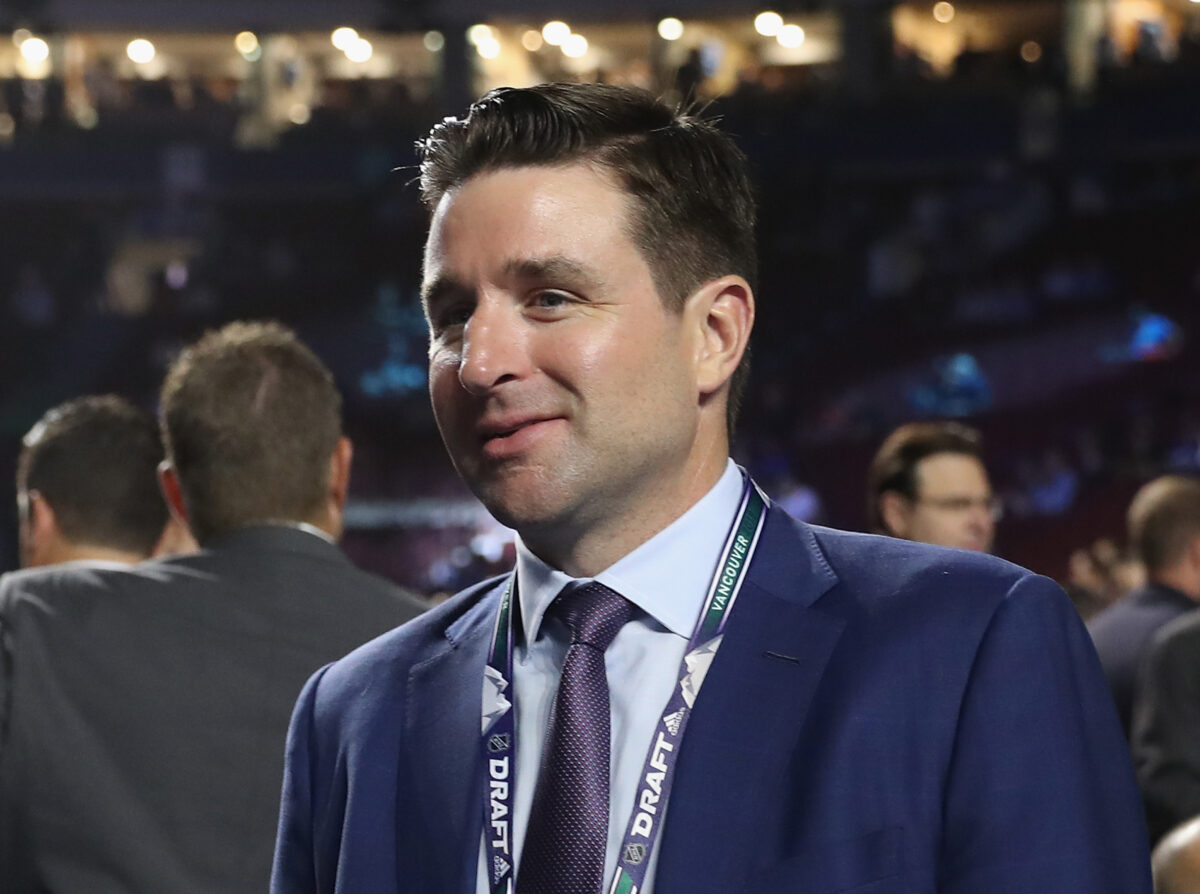
Until the deadline, though, Gallant should lean on Goodrow again, this time as the centerpiece of his attempt to build a viable third forward unit. If the coach can find a combination that clicks, the Rangers might go from surprise playoff contender to sleeper pick to emerge from the Eastern Conference – just like their deep brethren of 2013-14.